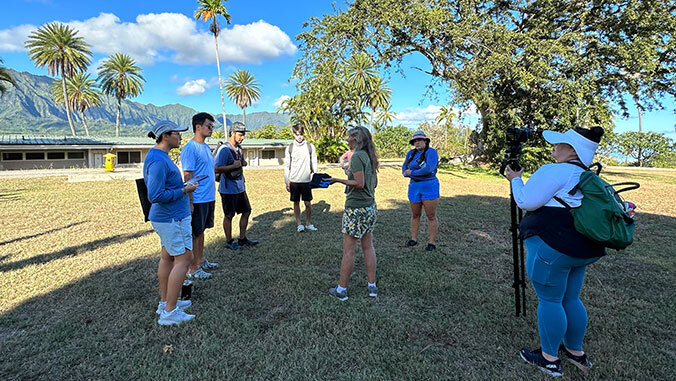
A weekend overnight field school on Moku o Loʻe (Coconut Island) for University of Hawaiʻi at Mānoa students highlighted the intersection of environmental stewardship, the pressing issue of sea-level rise due to climate change and interdisciplinary collaboration.
Six students were selected to participate in the field school led by Phoebe White, assistant professor of landscape architecture and Priyam Das, associate professor and chair of the Department of Urban and Regional Planning (DURP) and hosted by the Hawaiʻi Institute of Marine Biology. It provided hands-on experience as students examined and addressed the impacts of coastal erosion and sea-level rise. The program, held in October, showcased the power of collaboration across disciplines for effective climate change adaptation.

The students represented programs at the School of Architecture, DURP in the College of Social Sciences, and the Department of Civil, Environmental, and Construction Engineering in the College of Engineering.
Student experiences
“The on-site experience, engaging in conversations with scientists, enriched my understanding not only of sea-level rise issues but also illuminated the significance of the facilities and their connection to the broader scientific research process,” said Sandy Kim, a PhD student in DURP.
Dingyi Liu, a master’s student in DURP, echoed the importance of interdisciplinary learning.
“The ideas from my peers in architecture and civil engineering opened my eyes and helped me gain a deeper understanding of site planning and adaptation to sea-level rise,” he said.
Participants experienced a unique blend of theoretical and practical knowledge.
“Through teamwork, I gained insight into different perspectives and seeing how different majors collaborate,” said Gavin Kondo, an engineering senior. “Visiting Coconut Island enhanced my understanding of coastal issues, assisting in my decision to pursue a master’s in coastal engineering.”
The field school, made possible through funding from the Bowers + Kubota Endowment, was a collaboration between the School of Architecture, the Department of Urban and Regional Planning, the Department of Civil, Environmental and Construction Engineering.

